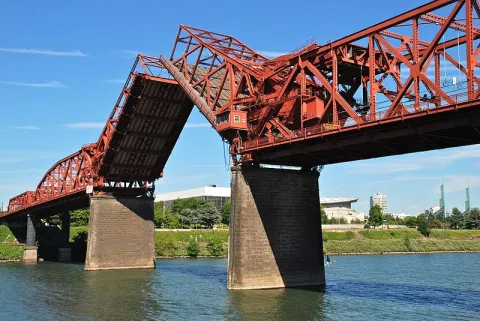
Type: Rall-type double-leaf bascule
Opened: 1913
Length: 1613 ft
Width: 70 ft
Lanes: 4
Traffic: 30,000 vehicles/day
(Photo credit: Steve Morgan, CC-BY-SA.)
The Broadway Bridge was built in 1911-12, with a new approach added in 1927 and an old approach replaced by the City of Portland in 1999-2002. It carries four lanes of automobile traffic and one streetcar line, and is also a popular river crossing for people on bicycles. It was originally painted black, but was repainted to “Golden Gate Red” in 1963.
Vertical clearance of the closed bascule span is adequate for the majority of river traffic, with openings necessary about 25 times per month, primarily to accommodate grain terminal ships.
The full structure totals 1,613 feet in length and consists of a 278-foot double-leaf Rall bascule main channel draw span, three Pennsylvania-Petit Through truss spans of 270 feet, 286 feet and 297 feet on the western approach, and one Pennsylvania-Petit Through truss of 297 feet and one Warren Through truss of 185 feet on the eastern approach.
The NW Broadway approach ramp on the west side is a combination of structures built in 1911 and 1927. The first 456 feet is a concrete roadway slab with retaining walls, originally 67 feet wide but later widened to 85 feet in 1927. The next 331 feet consists of six spans made up of a concrete deck supported by steel girders, floor beams, stringers and columns. This section is connected to a steel Viaduct Intersection, which is 282 feet long, has four variable length steel girder spans, and connects the approach to the bridge structure.
The NW Lovejoy Street approach ramp was originally constructed in 1927. This approach was torn down by the City of Portland in 1999 and re-opened as a shorter approach in 2002 in order to allow for development of the new River District residential area.
The east approach to the bridge is a two-span continuous concrete deck girder bridge 84 feet long crossing over N Interstate Avenue. The end abutment walls are approximately 20 feet high.
Commuters sitting in traffic may notice that Broadway openings take longer than other movable bridges. Average opening times for Morrison, Burnside and Hawthorne bridges run from five to eight minutes. On the Broadway, openings can take 20 minutes or longer.
One reason for the delays is that Broadway is a very complicated drawbridge. Called a double-leaf bascule (meaning “seesaw” in French), the weight of the deck, or leaf, is balanced by a counterweight. Portland's two other bascules, Morrison and Burnside, have counterweights hidden out of sight inside their piers. Broadway's two counterweights, however, are located above the bridge's deck.
The Broadway bascule span is an unusual Rall-type bascule, invented by Theodore Rall. On this bridge, each leaf and its counterweight roll back and forth on giant bull wheels to allow maximum river clearance. Only three Rall-bascule highway bridges still exist in the U.S., the other two being much smaller than the Broadway. The bridge's draw span is unusually long. Each leaf measures about 140 feet, weighing more than 2,000 tons, making Broadway the seventh longest bascule bridge in the world.
The overall Broadway Bridge was designed by Ralph Modjeski of Chicago, IL. The bascule span was designed by the Strobel Engineering Company of Chicago, holder of the Rall patent. The Union Bridge and Construction Co. of Kansas City, MO constructed the substructure and the Pennsylvania Steel Co. of Steelton, PA fabricated and erected the steel and bascule spans. In 1927, another famous bridge engineer, Gustav Lindenthal of New York, designed part of the Lovejoy Street ramp as well as modifications to the truss spans.
